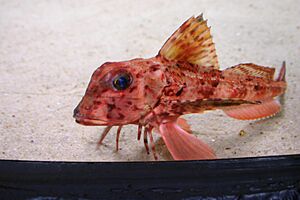Red gurnard facts for kids
Quick facts for kids Red gurnard |
|
|---|---|
 |
|
| Conservation status | |
| Scientific classification | |
| Genus: |
Chelidonichthys
|
| Species: |
cuculus
|
| Synonyms | |
|
|
The red gurnard (Chelidonichthys cuculus) is a type of fish that lives near the bottom of the ocean. It's also known as the East Atlantic red gurnard or soldier. This fish belongs to a group called ray-finned fishes and is part of the Triglidae family. This family includes other gurnards and sea robins. You can find the red gurnard in the eastern Atlantic Ocean, which includes the Mediterranean Sea and the Black Sea.
Contents
What's in a Name?
The red gurnard was first officially described in 1758. A famous scientist named Carl Linnaeus gave it the name Trigla cuculus. He wrote about it in his book, Systema Naturae. The word cuculus is Latin for "cuckoo". This name might have come from an old idea by Aristotle. He thought that gurnards made sounds like a cuckoo bird when they were taken out of the water.
What Does the Red Gurnard Look Like?
The red gurnard has a big, angular head. Its snout sticks out forward and is flat with two small bumps. These bumps are covered in tiny tooth-like structures.
Fins and Scales
This fish has two dorsal fins on its back. The first one has 9 or 10 stiff spines. The second dorsal fin has 17 to 19 soft rays. Its anal fin on the belly has 16 to 18 soft rays. The pectoral fins, which are like arms, have 2 or 3 special, separate rays. These rays are larger than the others. The scales along its side look like tall, thin plates. Interestingly, its chest and the front part of its belly have no scales at all.
Colors
The red gurnard is bright red on its upper body. Its lower body is much paler. The fins on its belly are pink. The anal fin is white near its base, while the pectoral and dorsal fins are yellowish. This fish can grow up to about 70 centimeters (27.5 inches) long. However, most males are around 27.6 cm (10.9 in) and females are about 20.4 cm (8 in).
Where Do Red Gurnards Live?
You can find the red gurnard in the eastern Atlantic Ocean. Its range stretches from southern Scotland all the way south to Mauritania. It also lives near islands like Madeira, the Azores, and the Canary Islands. It is very common throughout the Mediterranean Sea and in the Black Sea.
Habitat
This fish lives on the ocean floor. It has been found at depths from 15 to 400 meters (49 to 1,312 feet). But usually, you'll find it between 30 and 250 meters (98 and 820 feet) deep. Red gurnards prefer areas with sand or gravel. However, they can also be found in rocky or muddy places.
Red Gurnard's Life and Habits
Scientists studied red gurnards in the Adriatic Sea. They found that these fish mostly eat crustaceans, which are like small crabs and shrimp. More than 90% of their diet is made up of these creatures. They also eat small amounts of other fish, molluscs (like snails), and echinoderms (like starfish).
How They Find Food and Communicate
Red gurnards use those special, separate rays on their pectoral fins to find food. These rays act like feelers, helping them detect prey on the seabed. This species is also known to make sounds. People have said they croak like a frog!
Reproduction and Life Cycle
Sometimes, red gurnards gather together in groups called schools. They usually lay their eggs during the summer months. Red gurnards become old enough to reproduce when they are about 26.6 centimeters (10.5 inches) long. The oldest red gurnard ever recorded lived to be 21 years old.
Red Gurnards and Fishing
In the Atlantic Ocean, red gurnards are not usually caught for commercial fishing. However, they might be caught by accident when people are fishing for other types of fish. In England, red gurnards are caught off the Cornwall coast. This is becoming a bit more popular, but it's still a small part of the fishing industry.
In the Mediterranean Sea, red gurnards are a minor commercial fish. You can often see them in fish markets in countries like Spain, Morocco, Italy, Cyprus, and Egypt. Sometimes, they are also sold in France, England, Greece, Ireland, and Turkey. However, they are rarely sold in Tunisia. When caught, red gurnards are sold fresh, chilled, or frozen.



